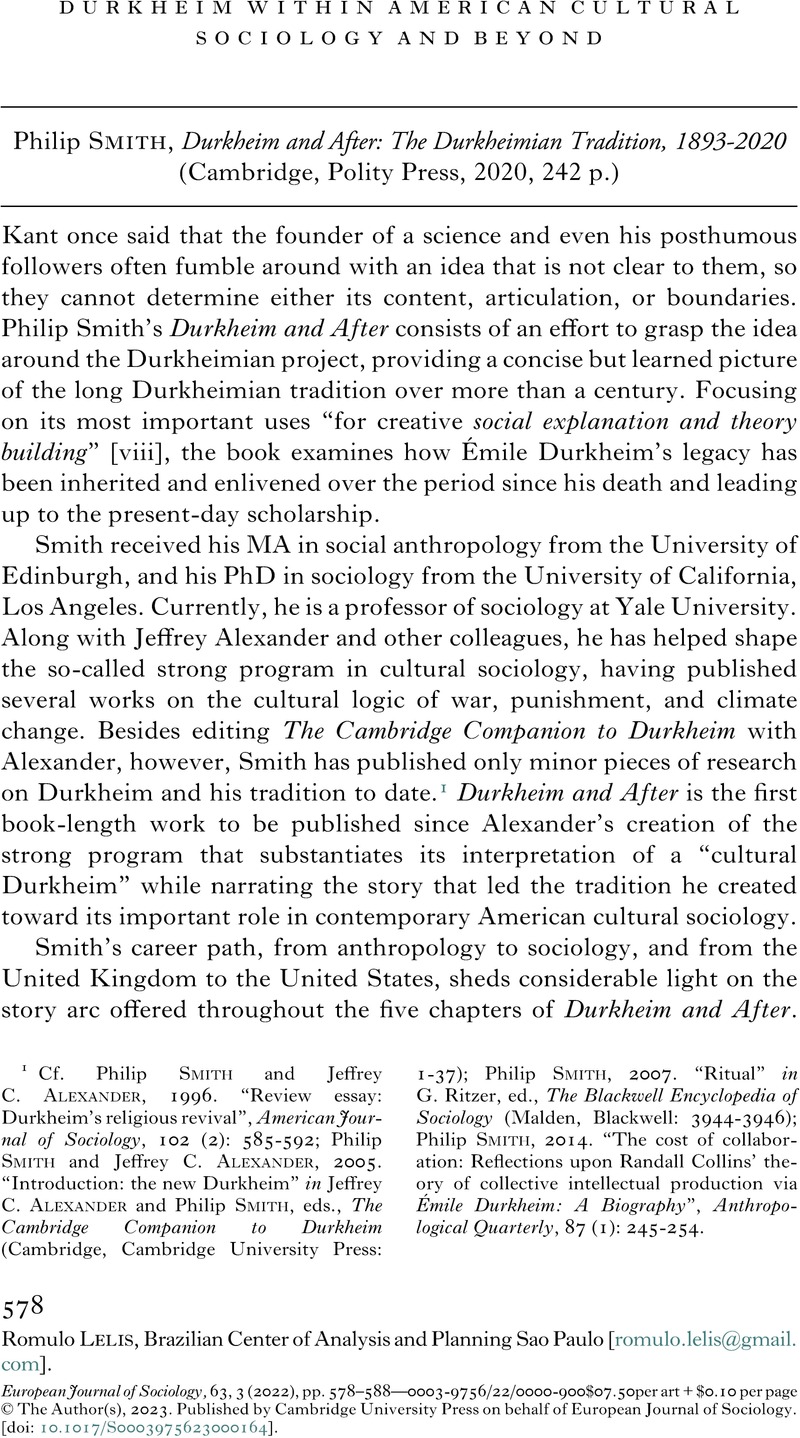No CrossRef data available.
Article contents
Durkheim Within American Cultural Sociology and Beyond - Philip Smith, Durkheim and After: The Durkheimian Tradition, 1893-2020 (Cambridge, Polity Press, 2020, 242 p.)
Review products
Published online by Cambridge University Press: 19 April 2023
Abstract

- Type
- Book Review
- Information
- European Journal of Sociology / Archives Européennes de Sociologie , Volume 63 , Issue 3 , December 2022 , pp. 578 - 588
- Copyright
- © The Author(s), 2023. Published by Cambridge University Press on behalf of European Journal of Sociology
References
1 Cf. Philip Smith and Jeffrey C. Alexander, 1996. “Review essay: Durkheim’s religious revival”, American Journal of Sociology, 102 (2): 585-592; Philip Smith and Jeffrey C. Alexander, 2005. “Introduction: the new Durkheim” in Jeffrey C. Alexander and Philip Smith, eds., The Cambridge Companion to Durkheim (Cambridge, Cambridge University Press: 1-37); Philip Smith, 2007. “Ritual” in G. Ritzer, ed., The Blackwell Encyclopedia of Sociology (Malden, Blackwell: 3944-3946); Philip Smith, 2014. “The cost of collaboration: Reflections upon Randall Collins’ theory of collective intellectual production via Émile Durkheim: A Biography”, Anthropological Quarterly, 87 (1): 245-254.
2 Paul Carls, 2021. “The unrecognized genius of Durkheim”, Journal of Classical Sociology, 22 (1): 123-130; Matt Dawson, 2022. “Book review: Durkheim and After: The Durkheimian Tradition, 1893-2020”, Thesis Eleven, 169 (1): 117-121; Christopher Thorpe, 2022. “Book review: Durkheim and After: The Durkheimian Tradition, 1893-2020”, European Journal of Social Theory, 25 (3): 496-500.
3 Cf. Jeffrey C. Alexander, 1982. Theoretical Logic in Sociology, Vol. II The Antinomies of Classical Thought: Marx and Durkheim (Berkeley, University of California Press); Jeffrey C. Alexander, 2005. “The inner development of Durkheim’s sociological theory: From early writings to maturity,” in Jeffrey C. Alexander and Philip Smith, eds., The Cambridge Companion to Durkheim (Cambridge, Cambridge University Press: 136-159).
4 Page 17, in William Watts Miller, 2013. “Total aesthetics: Art and The Elemental Forms,” in Alexander Riley, W.S.F. Pickering and William Watts Miller, eds., Durkheim, the Durkheimians, and the Arts (Oxford, Durkheim Press/Berghahn Books: 16-42).
5 Cf. Émile Durkheim, 2020. “Un manuscrit inédit de Durkheim: Physique générale du droit et des mœurs, IVe Année du Cours. 1re Leçon, 2 Décembre 1899, Plan du Cours—Les Sanctions pénales,” Durkheimian Studies, 24: 33-44 [https://doi.org/10.3167/ds.2020.240103].
6 Pages 618 and 620, in Steven Lukes, 1977. “Appendix A: Courses of lectures given by Durkheim at Bourdeaux and Paris,” in Steven Lukes, Émile Durkheim, His Life and Work (Harmondsworth, Penguin: 617-620).
7 Page 162, in David A. Palmer, 2019. “Cosmology, gender, structure, and rhythm: Marcel Granet and Chinese religion in the history of social theory”, Review of Religion and Chinese Society, 6 (2): 160-187.
8 Page 196, in Michèle H. Richman, 2002. Sacred Revolutions: Durkheim and the Collège de Sociologie (Minneapolis, University of Minnesota Press).
9 Page 197, Ibid.


